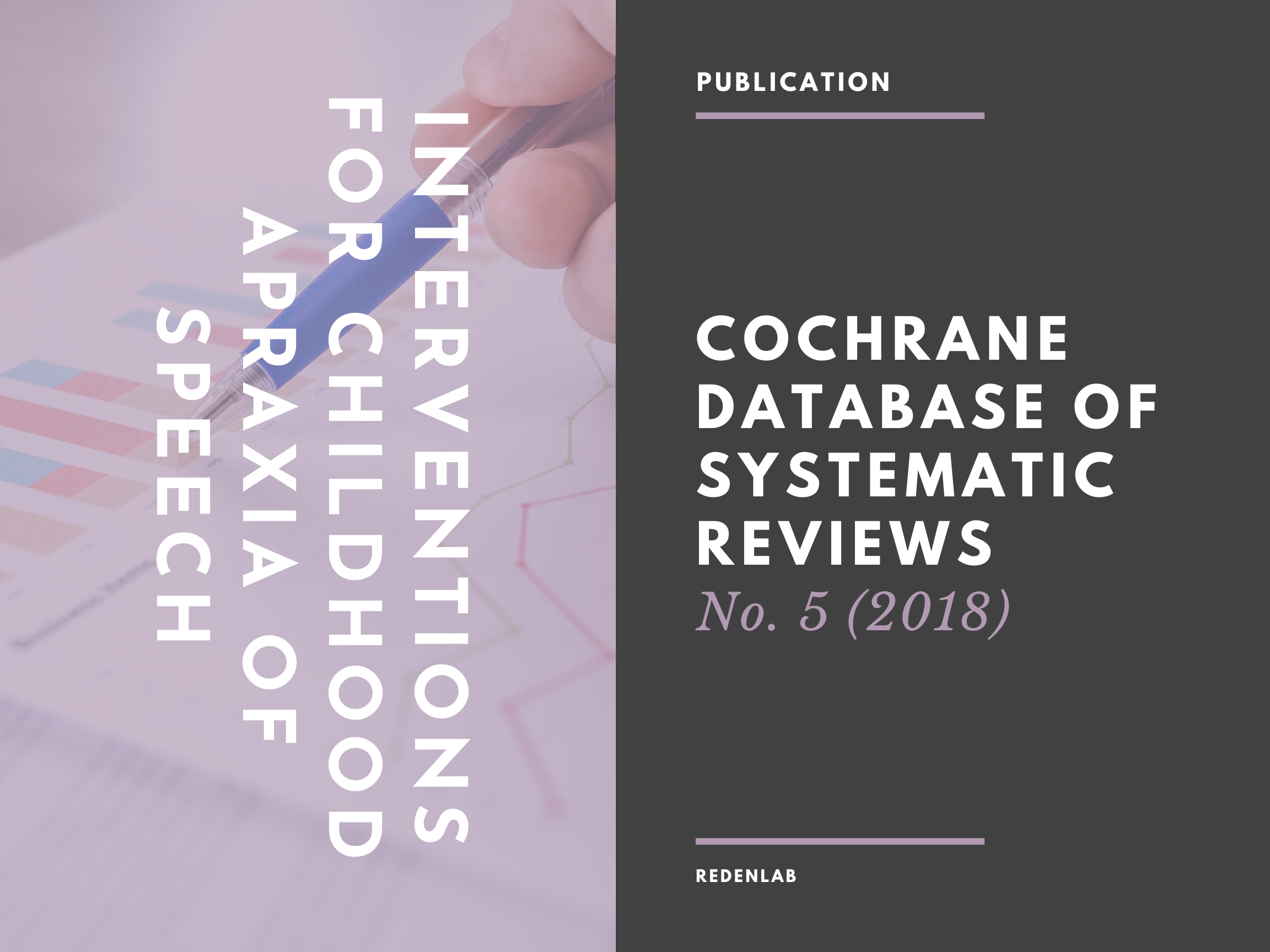SCIENCE: Systematic review of Interventions for childhood apraxia of speech

BACKGROUND:
Childhood apraxia of speech (CAS) affects a child’s ability to produce sounds and syllables precisely and consistently, and to produce words and sentences with accuracy and correct speech rhythm. It is a rare condition, affecting only 0.1% of the general population. Consensus has been reached that three core features have diagnostic validity: (1) inconsistent error production on both consonants and vowels across repeated productions of syllables or words; (2) lengthened and impaired coarticulatory transitions between sounds and syllables; and (3) inappropriate prosody (ASHA 2007). A deficit in motor programming or planning is thought to underlie the condition. This means that children know what they would like to say but there is a breakdown in the ability to programme or plan the fine and rapid movements required to accurately produce speech. Children with CAS may also have impairments in one or more of the following areas: non-speech oral motor function, dysarthria, language, phonological production impairment, phonemic awareness or metalinguistic skills and literacy, or combinations of these. High-quality evidence from randomised controlled trials (RCTs) is lacking on interventions for CAS.
OBJECTIVES:
To assess the efficacy of interventions targeting speech and language in children and adolescents with CAS as delivered by speech and language pathologists/therapists.
SEARCH METHODS:
We searched CENTRAL, MEDLINE, Embase, eight other databases and seven trial registers up to April 2017. We searched the reference lists of included reports and requested information on unpublished trials from authors of published studies and other experts as well as information groups in the areas of speech and language therapy/pathology and linguistics.
SELECTION CRITERIA:
RCTs and quasi-RCTs of children aged 3 to 16 years with CAS diagnosed by a speech and language pathologist/therapist, grouped by treatment types.
DATA COLLECTION AND ANALYSIS:
Two review authors (FL, AM) independently assessed titles and abstracts identified from the searches and obtained full-text reports of all potentially relevant articles and assessed these for eligibility. The same two authors extracted data and conducted the ‘Risk of bias’ and GRADE assessments. One review author (EM) tabulated findings from excluded observational studies (Table 1).
MAIN RESULTS:
This review includes only one RCT, funded by the Australian Research Council; the University of Sydney International Development Fund; Douglas and Lola Douglas Scholarship on Child and Adolescent Health; Nadia Verrall Memorial Scholarship; and a James Kentley Memorial Fellowship. This study recruited 26 children aged 4 to 12 years, with mild to moderate CAS of unknown cause, and compared two interventions: the Nuffield Dyspraxia Programme-3 (NDP-3); and the Rapid Syllable Transitions Treatment (ReST). Children were allocated randomly to one of the two treatments. Treatments were delivered intensively in one-hour sessions, four days a week for three weeks, in a university clinic in Australia. Speech pathology students delivered the treatments in the English language. Outcomes were assessed before therapy, immediately after therapy, at one month and four months post-therapy. Our review looked at one-month post-therapy outcomes only.We judged all core outcome domains to be low risk of bias. We downgraded the quality of the evidence by one level to moderate due to imprecision, given that only one RCT was identified. Both the NDP-3 and ReST therapies demonstrated improvement at one month post-treatment. A number of cases in each cohort had recommenced usual treatment by their speech and language pathologist between one month and four months post-treatment (NDP-3: 9/13 participants; ReST: 9/13 participants). Hence, maintenance of treatment effects to four months post-treatment could not be analysed without significant potential bias, and thus this time point was not included for further analysis in this review.There is limited evidence that, when delivered intensively, both the NDP-3 and ReST may effect improvement in word accuracy in 4- to 12-year-old children with CAS, measured by the accuracy of production on treated and non-treated words, speech production consistency and the accuracy of connected speech. The study did not measure functional communication.
AUTHORS’ CONCLUSIONS:
There is limited evidence that, when delivered intensively, both the NDP-3 and ReST may effect improvement in word accuracy in 4- to 12-year-old children with CAS, measured by the accuracy of production on treated and non-treated words, speech production consistency and the accuracy of connected speech. The study did not measure functional communication. No formal analyses were conducted to compare NDP-3 and ReST by the original study authors, hence one treatment cannot be reliably advocated over the other. We are also unable to say whether either treatment is better than no treatment or treatment as usual. No evidence currently exists to support the effectiveness of other treatments for children aged 4 to 12 years with idiopathic CAS without other comorbid neurodevelopmental disorders. Further RCTs replicating this study would strengthen the evidence base. Similarly, further RCTs are needed of other interventions, in other age ranges and populations with CAS and with co-occurring disorders.
Click here for more details.
